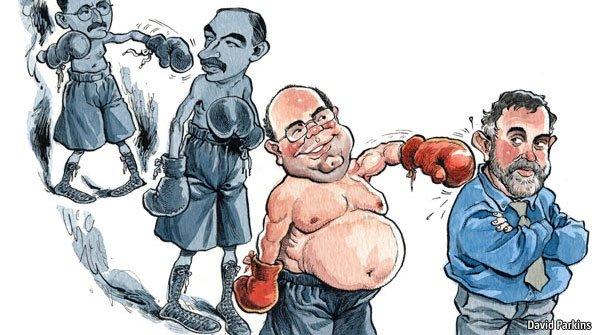
While it is sometimes portrayed as a trivial assortment of anecdotes and odd or mistaken experiments, stripped of its hyperbole and properly contextualized, behavioral economics can offer insights to Austrians seeking to optimize their own outcomes.
At its most basic level, behavioral economics simply argues that as individuals purposefully pursue their certain ends, they sometimes find themselves confronted by a choice architecture that leads to systemic miscalculation. A well-known example that has been confirmed in dozens of studies around the world over the past fifty years is prospect theory—the tendency of individuals to overestimate the likelihood of extremely rare events, underestimate the occurrence of more likely events under certain conditions, and make suboptimal economic decisions as a result.
Framing, another well-documented cognitive bias, plays a large role in such instances. For example, individuals shown higher numbers than another group were more likely to overestimate the price of a given item—the so-called anchoring effect. Unknowing participants in a fixed group game in which all other participants surreptitiously but purposefully chose incorrect answers also displayed a willingness to choose knowingly wrong answers—the herd effect—in the process actually beginning to rewire their own brains, making the lie true!
These are but a few examples of a host of heuristics and biases behavioral economists and psychologists have documented. An assumption of neoclassical modeling is that mistakes will be randomly distributed in a familiar bell shape, that any mistakes in pricing assets, for example, will naturally tend to revert to the mean. This finding has important consequences.
To take just one example, that of the great financial crisis, the level of systematic risk most major market actors assigned their own position was systemically wrong: it turned out combining a lot of bad investments, dividing them into pieces, and then dividing them into tranches did not alter the fundamental fact that these had all been bad investments. And in the case of the value at risk model and the subprime mortgage-backed securities markets, aggregation produced overleveraged monstrosities that paralyzed and then wrecked much of the developed global economy.
The thing to note in the above example, however, is that even though the entire subprime mortgage industry was full of bad incentives from top to bottom—from its ultimate government backstopping to the originate-to-distribute model of mortgage lending, from the opaque nature of the synthesized derivatives being traded to the obvious conflicts of interest between ratings agencies and their clients who came demanding investment-grade ratings for bonds that even they sometimes knew were utter junk. These mortgage-backed securities were the most profitable investment going for the entire decade before the crash.
Driving this sentiment was a story: that US housing prices historically only went up. In the actual real estate market, this greater fool assumption was borne out by numerous examples of buyers buying with the intention of simply reselling six months later. By 2007, flipping had become a national cottage industry!
Conceptualized game theoretically, the situation facing the prospective Austrian investor looked like this:
Whether to participate in an “irrational” market
Post-Keynesian/neoclassical market actors
Participate
Don’t participate
Austrian market actors
Participate
100, 100
100, 0
Don’t participate
0, 100
0, 0
In this common game setup, it is clear that the only rational choice for anyone desiring to make a return is to participate—in the case of Austrians, to ape the irrationality of the bulk of market participants. This is, of course, only true given a certain level of risk tolerance. Even if one were risk preferring, the Nash equilibrium could change radically—and it eventually did, when enough market participants became aware of the actual values and risk levels of their holdings.
It is clear in retrospect that a peculiar though familiar recursive loop fueled the crisis: the returns on mortgage-backed securities spurred increased demand, which prompted a search for more supply until the mortgage originators finally ran out of prime and even reasonable subprime lending candidates. But even at the time, as housing prices rose precipitously, several prominent economists warned publicly of an impending crash, and some individual and institutional investors took big positions against the mortgage-backed securities market via credit default swaps. Those insightful and daring few got paid, while the rest lost out.
For the Austrian, this example can be applied more broadly: What should one do when, from their perspective, the overwhelming majority of market participants are making systematic mistakes not only in asset pricing but in their assumptions about money, interest rates, even value?
Because really, from the Austrian perspective, one must behave irrationally from start to finish to participate in modern financial markets at all. But knowing, or rather probabilistically assuming, that most market participants will act irrationally by going along with the status quo of modern monetary madness, Austrians too must participate if they are to realize optimal gains—at least, they must participate until they feel that the risk of continuing to do so outweighs the likely payoff of continuing to ape the irrational behavior of the post-Keynesian financial landscape.
Thinking about Menger’s thought experiment illustrating the power of the subjective theory of value helps further clarify the dynamic: stranded on a desert island in the middle of the ocean, one values a glass of water more than a diamond, but probably only there or under a few other highly constrained circumstances.
Austrians understand real value, profit, better than any other economic school—but that doesn’t mean they are immune to choice architecture or to the madness of crowds. While in the long run, true value always wins out, in the short to medium term, prices are bound up in market sentiment, momentum, and many other things that make all prices, “always wrong in retrospect,” as efficient market hypothesis theorist Eugene Fama admitted. This is because complete information is difficult to obtain in hindsight, and impossible to obtain in the actual moment.
Behavioral economics gives Austrians clear concepts for identifying and understanding the various kinds of misbehavior that can and have occurred in financial markets. With this understanding, Austrians can better avoid being sucked into risky investment fads like memes or nonfungible tokens. In addition, because behavioral economics can help reveal when and how market participants are likely to be systematically mistaken about the value of something, aware Austrians can take advantage of price-arbitraging opportunities over the long run by staying focused on consumer demands and business responses.
As for behavioralists seeking a more predictable macroenvironment for their choice architecture, Austrian business cycle theory offers just such a matrix. After all, how is one to predict a world interest rate set by a handful of unelected members of a private monopoly? Would not pure market forces and a less elastic medium be preferable?
From the perspective of limiting risk, unassailably yes!
To preemptively address any behavioralist objection at the apparent contradiction within ABCT that lenders would continue to lend despite recognizing the economy was growing too hot, as Joseph Salerno has explained, this is no contradiction at all. The reason was put perfectly by an investment manager on CNBC some months ago, “As long as the music is still playing, we have to get up and dance, and the music is still playing.”
Client demand for returns might build bubbles, but bad monetary policy is what allows them to grow to truly dangerous proportions. Today, it should be clear to everyone that the Federal Reserve kept the latest party running far too long.
The question now is how much further down there is to go.





